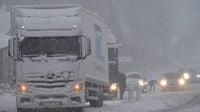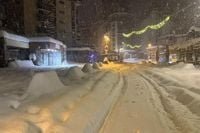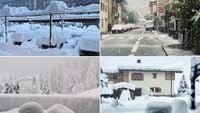On Thursday, April 17, 2025, heavy snowfall hit the French Alps, particularly affecting the departments of Savoie, Haute-Savoie, and Isère. Reports indicate that some resorts, including Tignes and Val d'Isère, received up to 86 centimeters of snow, rendering roads impassable that morning. The snowfall comes just days before the Easter holidays, and the Savoie department has been placed under an orange alert due to avalanche risks, especially in the Maurienne and Tarentaise regions.
In Val d'Isère, which sits at 1,850 meters, the village recorded 86 centimeters of snow in just 15 hours, with over 1.20 meters accumulating in higher altitude sectors, such as the Solaise massif at 2,500 meters. "The access road to Val d'Isère is closed to all traffic until further notice due to snow slides and fallen trees on the D902," the resort stated in a press release. Pedestrians in the heart of the resort found themselves wading through snow that reached up to their knees, necessitating careful movement.
Meanwhile, in Bonneval-sur-Arc, located in the Maurienne valley, driving conditions were similarly challenging as nearly one meter of snow blanketed the area. The snowfall even reached lower valleys, with Moûtiers, situated at less than 500 meters altitude, experiencing significant snow accumulation. "Due to isothermic effects, snow has reached the lowest valleys of Savoie today! Big flakes are whitening the town of Moûtiers at only 500 meters altitude!" noted a local weather service.
In Haute-Savoie, the Tour area near Chamonix saw nearly 33 centimeters of snow. The Mont-Blanc tunnel was partially closed, prohibiting heavy goods vehicles since 8 a.m. that morning. Residents in the Chamonix valley awoke to a winter wonderland, with many taking to social media to share videos of their snow-covered gardens, while others detailed the complications they faced while traveling.
As for Isère, the Alpe d'Huez recorded 27 centimeters of fresh snow, with a thick white blanket covering the ground in mid-mountain resorts like Chamrousse and Villards-de-Lans. Météo France predicted significant precipitation across the Alps until midday on April 17, with the most substantial accumulations expected at the Italian border, particularly in Haute-Maurienne and Haute-Tarentaise.
On the roads, travel was heavily disrupted. The A40 was closed to traffic near Passy, heading towards Chamonix-Mont-Blanc, due to an accident involving two trucks. Motorists were advised to exit at Sallanches and rejoin the highway at Fayet. The Mont-Blanc tunnel remained closed to heavy goods vehicles, and the Col de la Forclaz, a crucial crossing point between France and Switzerland, was also closed.
In Savoie, the Fréjus tunnel was prohibited for heavy goods vehicles but remained accessible to light vehicles. The local prefecture urged motorists to postpone their journeys on the road networks of Maurienne and Tarentaise, particularly above 700 meters, due to heavy snowfall and the risk of falling trees. The weather conditions have led to power outages affecting around 4,000 homes, and several roads were closed due to fallen trees.
Météo France has warned that the situation is precarious, with avalanche risks rated at 4 out of 5 in Maurienne, Tarentaise, and Vanoise regions. The Mont Blanc massif has also been placed under a similar alert. The forecast indicates that by Thursday evening, up to two meters of cumulative snowfall could be expected in Haute-Maurienne and Haute-Tarentaise.
In Val d'Isère, the ski area reported that it was "awaiting further snowfall throughout the day," and that the ski domain was undergoing security measures. The avalanche risk was rated at 5 out of 5 for off-piste areas. As the snow continued to fall, local authorities and ski resorts prepared for the influx of holidaymakers expected for the Easter break.
As the day progressed, the weather was expected to improve around midday, providing some relief from the heavy snowfall. However, the impact of the storm was felt far and wide, with travelers urged to stay informed and heed local advisories.
This unexpected return of winter in mid-April has left many residents and visitors in awe of the powerful forces of nature at play in the French Alps, reminding everyone of the unpredictability of mountain weather.



